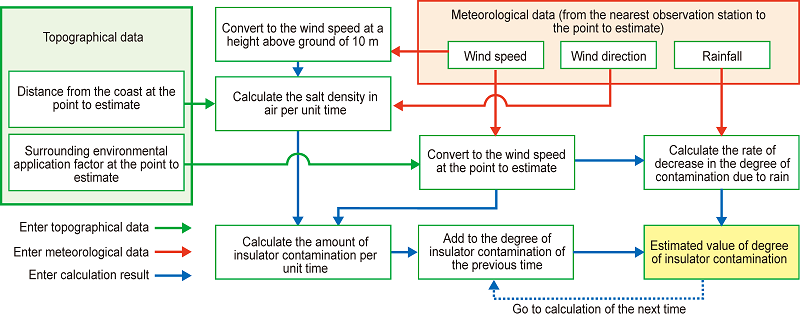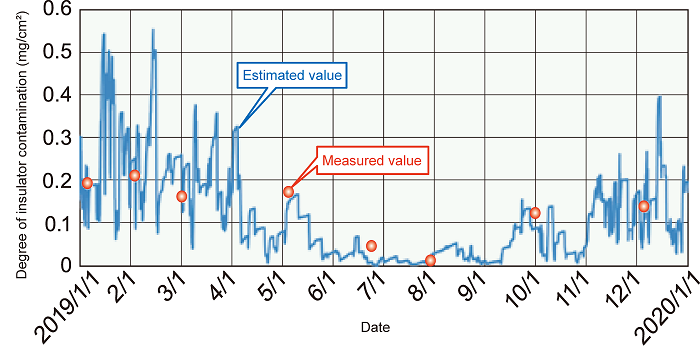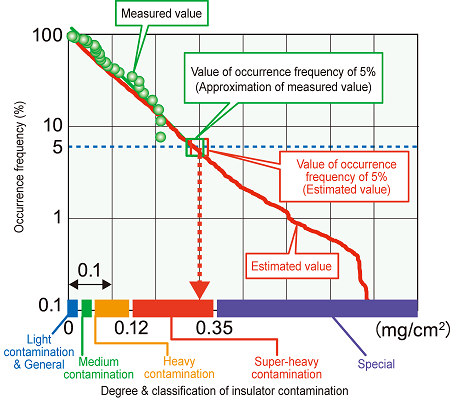17. Insulator contamination estimation method based on public data
If an insulator is contaminated by salt, etc. adhered on the surface, the insulation performance is degraded, so the equipment should be designed and cleaned according to the degree of contamination. Currently, the contamination level is classified uniformly based on the distance from the coastline. If this can be subdivided, it is expected to improve safety and reduce the labor required for maintenance. In order to do this, it is necessary to continuously monitor the degree of insulator contamination at many points, but a lot of labor is required to do this by actual measurement.
Therefore, we have developed a method to estimate the degree of insulator contamination at any given point and time in an open section using meteorological data such as wind speed, wind direction, and rainfall, and topographical data such as distance from the coastline (Fig. 1). Fig. 2 shows the results of estimating the degree of insulator contamination at the Anti-Salt Testing Station in Gatsugi of RTRI (Murakami-shi, Niigata) over a one-year period, as well as the measured values. For the degree of insulator contamination under an occurrence frequency of 5%, which is used when designing the contamination resistance of equipment, the results based on the estimated values for three years by this method and the measured values for the same period were found to be in good agreement with each other (Fig. 3). From these results, we have confirmed that this method has a practical estimation accuracy. With this method, it is possible to design contamination resistance and maintenance methods according to the environment, such as increasing the size and number of couplings of insulators at points with high levels of contamination, and extending the cleaning interval of insulators at points with low levels of contamination.
Other Contents
- 9. Restoration techniques for embankments reusing collapsed soil
- 10. Structural performance evaluation of existing bridges by acceleration monitoring
- 11. Multi-point synchronous measurement system for railway bridge vibration using a video camera
- 12. Low-cost deterioration evaluation method for the backside ground of slope protection works
- 13. Boring method for constructing a crossing structure under railway tracks making it possible to shorten the construction period
- 14. Maintenance method for prestressed concrete sleepers according to the installation environment
- 15. Low-cost ballastless tracks for existing lines and roadbed improvement method
- 16. The image analysis engine for around track to support train patrol
- 17. Insulator contamination estimation method based on public data
- 18. Degradation evaluation method for lithium-ion batteries for vehicle control circuits
- 9. Restoration techniques for embankments reusing collapsed soil
- 10. Structural performance evaluation of existing bridges by acceleration monitoring
- 11. Multi-point synchronous measurement system for railway bridge vibration using a video camera
- 12. Low-cost deterioration evaluation method for the backside ground of slope protection works
- 13. Boring method for constructing a crossing structure under railway tracks making it possible to shorten the construction period
- 14. Maintenance method for prestressed concrete sleepers according to the installation environment
- 15. Low-cost ballastless tracks for existing lines and roadbed improvement method
- 16. The image analysis engine for around track to support train patrol
- 17. Insulator contamination estimation method based on public data
- 18. Degradation evaluation method for lithium-ion batteries for vehicle control circuits



